Seasonal Vegetation Trends for Europe over 30 Years from a Novel Normalised Difference Vegetation Index (NDVI) Time-Series—The TIMELINE NDVI Product
Abstract
1. Introduction
2. Materials and Methods
2.1. TIMELINE Project Area
2.2. TIMELINE NDVI Data
2.3. Investigation of Available TIMELINE Monthly NDVI Composite Data
2.4. Pre-Processing of TIMELINE NDVI Time-Series for Trend Analysis
2.5. Seasonal Trend Analyses
3. Results
3.1. Spatial and Temporal Availability of TIMELINE Monthly NDVI Time-Series Data
3.2. Seasonal NDVI Trends for Spring, Summer, Autumn and the Growing Season (1989–2018)
4. Discussion
4.1. Data Availability within the TIMELINE L3 Monthly NDVI Product
4.2. Generation of Continuous NDVI Time-Series
4.3. Discussion and Comparison of NDVI Trends
4.4. Comparison of TIMELINE L3 NDVI and Other AVHRR NDVI Products
| Product | Spatial Coverage | Temporal Coverage | Spatial Resolution | Temporal Resolution | Produced by |
|---|---|---|---|---|---|
| TIMELINE L3 NDVI | Europe and northern Africa | 1981–2018 (will be continued) | 1 km | daily, 10 days, monthly | DLR |
| LTDR NDVI [115] | Global | 1981–present | 0.05 degree | daily | NASA |
| NOAA CDR of AVHRR NDVI V5 [35] | Global | 1981–present | 0.05 degree | daily | NOAA |
| Boston University NDVI [116] | Global | 1981–2001 | 16 km, 0.5 degree | monthly | Boston University |
| NDVI3g GIMMS [30,31] | Global | 1981–2015 | 1/12 degree | 15 days | NASA/GFSC |
| NDVI V2 (ENDVI10) [34] | Global | 2007–present | 1 km | 10 days | VITO/EUMETSAT LSA SAF |
| Crop Condition Assessment Program (CCAP) NDVI [36] | Canada | 1987–2020 | 1 km | daily, weekly | Statistics Canada |
| Sp_1 km_NDVI [38] | Spain | 1981–2015 | 1 km | semi-monthly | Spanish National Research Council |
4.5. Outlook and Further Development of TIMELINE L3 NDVI Product
5. Conclusions
- In spring, an area of 2,874,535 km2 (20.9% of the land area within the TIMELINE project area) shows a significant (p < 0.05) positive NDVI trend, while 496,748 km2 (3.6%) has a significant negative trend.
- The area with negative NDVI trends is largest for summer, with 853.141 km2 (6.2%) experiencing a significant negative trend. Including both significant and insignificant trends, a total area of 3,621,721 km2 (26.3%) is affected by negative trends in summer. Significant positive trends are observed in summer for 2,969,481 km2 (21.6% of the land area).
- In autumn, the areas affected by significant positive and negative trends cover 3,478,614 km2 (25.3%) and 626,095 km2 (4.6%), respectively. About 40% of the land area was masked due to low mean annual NDVI or low data availability in autumn.
- The average strength of the significant (p < 0.05) trends varies between spring, summer and autumn. The strongest average trends can be observed in autumn, with −0.12 NDVI units over the 30-year period 1989–2018 for negative trends and 0.14 NDVI units for positive trends. In summer, the average strength over all areas with significant trends is weakest, with about −0.1 NDVI units for negative trends and 0.09 NDVI units for positive trends, again, both given over the 30-year period 1989–2018.
- Scandinavia: Positive spring NDVI trends can be observed within a strip spreading from Norway over central Sweden to southern Finland. In summer, the region has mostly insignificant trends, but an NDVI increase can be observed along the eastern coast of Scandinavia.
- The north-eastern part of study area: The strip with positive spring NDVI trends observed for Scandinavia extends further east over northern Russia between 58°N and 65°N. In summer, this area shows mostly no NDVI trends, but positive trends can be found further south at about 53°N–58°N. In autumn, the most northern area was masked due to low data availability, but for the area from the Baltic states and Belarus towards the East, positive NDVI trends also dominate.
- The central-eastern part of the study area: In spring, most areas have no significant trend, but some regions in central Russia and northern Ukraine show a negative trend. In summer, a large region spreading over southern Russia and West Kazakhstan has significant negative NDVI trends. In autumn, a larger region covering parts of southern Russia and south-eastern Ukraine shows an outstanding NDVI decrease. The affected area and strength of the negative NDVI trends within this area increase from spring to autumn.
- Turkey: The coastal area along the Black Sea and western Turkey shows mainly positive trends for all three seasons. Along the northern coast, the strongest NDVI increase can be observed in spring. In central Turkey, several small areas are located that exhibit negative NDVI trends in summer and autumn.
- Central and southern Europe: In spring, for about half the area of the region, positive NDVI trends can be observed, which are located in specific regions such as in the Netherlands, eastern Germany, western Poland and Czechia. Positive spring trends also spread further southeast over Hungary, Romania, Serbia, Bulgaria, North Macedonia, Albania and Greece. Summer NDVI shows smaller areas with significant trends. These are also mostly positive, but less pronounced. Negative summer NDVI trends can be found for small patches in, e.g., Italy and Romania. Greece and Albania have relatively large areas with significant positive summer NDVI trends. In autumn, significant positive NDVI trends are widespread across the region.
- Western Europe: France and Great Britain show only few areas with significant trends in spring and summer, which are mostly positive, except for the northern part of Great Britain/Ireland and southern France, where several small areas with significant negative trends can be observed in summer. In autumn, large parts of the region experience significant positive NDVI trends.
- The Iberian Peninsula: For the Iberian Peninsula, all seasonal trends show patches of both positive and negative and insignificant NDVI trends. While positive trends dominate in spring and autumn, the summer trend is mostly negative, showing several regions with a decrease in the NDVI, except for the northern coast, where positive trends can be observed for all seasons.
- Northern Africa: Larger areas in Morocco show negative NDVI trends for all seasons, while coastal areas in Algeria and Tunisia also have negative trends in summer, but mostly positive trends in spring and autumn.
Author Contributions
Funding
Data Availability Statement
Acknowledgments
Conflicts of Interest
References
- Tollefson, J. Earth Is Warmer Than It’s Been in 125,000 Years, Says Landmark Climate Report. Nature 2021, 596, 171–172. [Google Scholar] [CrossRef]
- Ayanlade, A.; Sergi, C.M.; Di Carlo, P.; Ayanlade, O.S.; Agbalajobi, D.T. When Climate Turns Nasty, What Are Recent and Future Implications? Ecological and Human Health Review of Climate Change Impacts. Curr. Clim. Chang. Rep. 2020, 6, 55–65. [Google Scholar] [CrossRef]
- Jin, S.F.; Wang, L.X.; Yan, X.D. Climate change adaptation and disaster risk assessments: A preface. Phys. Chem. Earth 2020, 120, 2. [Google Scholar] [CrossRef]
- Mohanty, S.; Mohanty, B.P. Global climate change: A cause of concern. Natl. Acad. Sci. Lett. 2009, 32, 149–156. [Google Scholar]
- Kuenzer, C.; Dech, S.; Wagner, W. Remote Sensing Time Series Revealing Land Surface Dynamics: Status Quo and the Pathway Ahead. In Remote Sensing Time Series Analyses Revealing Land Surface Dynamics; Kuenzer, C., Dech, S., Wagner, W., Eds.; Springer: Dordrecht, The Netherlands, 2015; pp. 1–24. [Google Scholar]
- Anyamba, A.; Tucker, C.J. Analysis of Sahelian vegetation dynamics using NOAA-AVHRR NDVI data from 1981–2003. J. Arid. Environ. 2005, 63, 596–614. [Google Scholar] [CrossRef]
- Xue, X.; Wang, Z.J.; Hou, S.S. NDVI-Based Vegetation Dynamics and Response to Climate Changes and Human Activities in Guizhou Province, China. Forests 2023, 14, 753. [Google Scholar] [CrossRef]
- Momm, H.G.; ElKadiri, R.; Porter, W. Crop-Type Classification for Long-Term Modeling: An Integrated Remote Sensing and Machine Learning Approach. Remote Sens. 2020, 12, 449. [Google Scholar] [CrossRef]
- Tottrup, C.; Rasmussen, M.S. Mapping long-term changes in savannah crop productivity in Senegal through trend analysis of time series of remote sensing data. Agric. Ecosyst. Environ. 2004, 103, 545–560. [Google Scholar] [CrossRef]
- Prasad, N.R.; Patel, N.R.; Danodia, A. Cotton Yield Estimation Using Phenological Metrics Derived from Long-Term MODIS Data. J. Indian Soc. Remote Sens. 2021, 49, 2597–2610. [Google Scholar] [CrossRef]
- Gim, H.J.; Ho, C.H.; Jeong, S.; Kim, J.; Feng, S.; Hayes, M.J. Improved mapping and change detection of the start of the crop growing season in the US Corn Belt from long-term AVHRR NDVI. Agric. For. Meteorol. 2020, 294, 108143. [Google Scholar] [CrossRef]
- Cespedes, J.; Sylvester, J.M.; Perez-Marulanda, L.; Paz-Garcia, P.; Reymondin, L.; Khodadadi, M.; Tello, J.J.; Castro-Nunez, A. Has global deforestation accelerated due to the COVID-19 pandemic? J. For. Res. 2023, 34, 1153–1165. [Google Scholar] [CrossRef] [PubMed]
- Hamunyela, E.; Verbesselt, J.; de Bruin, S.; Herold, M. Monitoring Deforestation at Sub-Annual Scales as Extreme Events in Landsat Data Cubes. Remote Sens. 2016, 8, 651. [Google Scholar] [CrossRef]
- Gao, Y.; Quevedo, A.; Szantoi, Z.; Skutsch, M. Monitoring forest disturbance using time-series MODIS NDVI in Michoacan, Mexico. Geocarto Int. 2021, 36, 1768–1784. [Google Scholar] [CrossRef]
- DeVries, B.; Verbesselt, J.; Kooistra, L.; Herold, M. Robust monitoring of small-scale forest disturbances in a tropical montane forest using Landsat time series. Remote Sens. Environ. 2015, 161, 107–121. [Google Scholar] [CrossRef]
- Gabban, A.; Liberta, G.; San-Miguel-Ayanz, J.; Barbosa, P. Forest fire risk estimation from time series analysis of NOAA NDVI data. In Proceedings of the Remote Sensing for Agriculture, Ecosystems, and Hydrology V, Barcelona, Spain, 8–12 September 2003; pp. 587–595. [Google Scholar]
- Michael, Y.; Helman, D.; Glickman, O.; Gabay, D.; Brenner, S.; Lensky, I.M. Forecasting fire risk with machine learning and dynamic information derived from satellite vegetation index time-series. Sci. Total Environ. 2021, 764, 142844. [Google Scholar] [CrossRef] [PubMed]
- Walker, J.J.; Soulard, C.E. Phenology Patterns Indicate Recovery Trajectories of Ponderosa Pine Forests after High-Severity Fires. Remote Sens. 2019, 11, 2782. [Google Scholar] [CrossRef]
- Hellden, U.; Tottrup, C. Regional desertification: A global synthesis. Glob. Planet. Chang. 2008, 64, 169–176. [Google Scholar] [CrossRef]
- Sousa, W.R.N.; Couto, M.S.; Castro, A.F.; Silva, M.P.S. Evaluation of Desertification Processes in Ouricuri-PE Through Trend Estimates of Times Series. IEEE Lat. Am. Trans. 2013, 11, 602–606. [Google Scholar] [CrossRef]
- Zhao, X.W.; Yu, M.L.; Pan, S.; Jin, F.X.; Zou, D.X.; Zhang, L.X. Spatio-temporal distribution and trends monitoring of land desertification based on time-series remote sensing data in northern China. Environ. Earth Sci. 2023, 82, 263. [Google Scholar] [CrossRef]
- Hott, M.C.; Carvalho, L.M.T.; Antunes, M.A.H.; Resende, J.C.; Rocha, W.S.D. Analysis of Grassland Degradation in Zona da Mata, MG, Brazil, Based on NDVI Time Series Data with the Integration of Phenological Metrics. Remote Sens. 2019, 11, 2956. [Google Scholar] [CrossRef]
- Burrell, A.L.; Evans, J.P.; Liu, Y. Detecting dryland degradation using Time Series Segmentation and Residual Trend analysis (TSS-RESTREND). Remote Sens. Environ. 2017, 197, 43–57. [Google Scholar] [CrossRef]
- Paudel, K.P.; Andersen, P. Assessing rangeland degradation using multi temporal satellite images and grazing pressure surface model in Upper Mustang, Trans Himalaya, Nepal. Remote Sens. Environ. 2010, 114, 1845–1855. [Google Scholar] [CrossRef]
- Xulu, S.; Peerbhay, K.; Gebreslasie, M.; Ismail, R. Drought Influence on Forest Plantations in Zululand, South Africa, Using MODIS Time Series and Climate Data. Forests 2018, 9, 528. [Google Scholar] [CrossRef]
- Tian, F.; Wu, J.J.; Liu, L.Z.; Leng, S.; Yang, J.H.; Zhao, W.H.; Shen, Q. Exceptional Drought across Southeastern Australia Caused by Extreme Lack of Precipitation and Its Impacts on NDVI and SIF in 2018. Remote Sens. 2020, 12, 54. [Google Scholar] [CrossRef]
- Jia, L.; Yu, K.X.; Li, Z.B.; Li, P.; Xu, G.C.; Cheng, Y.T.; Zhang, X.; Yang, Z. The effect of meteorological drought on vegetation cover in the Yellow River basin, China. Int. J. Climatol. 2022, 42, 4830–4849. [Google Scholar] [CrossRef]
- Lieberherr, G.; Wunderle, S. Lake Surface Water Temperature Derived from 35 Years of AVHRR Sensor Data for European Lakes. Remote Sens. 2018, 10, 990. [Google Scholar] [CrossRef]
- Dech, S.; Holzwarth, S.; Asam, S.; Andresen, T.; Bachmann, M.; Boettcher, M.; Dietz, A.; Eisfelder, C.; Frey, C.; Gesell, G.; et al. Potential and Challenges of Harmonizing 40 Years of AVHRR Data: The TIMELINE Experience. Remote Sens. 2021, 13, 3618. [Google Scholar] [CrossRef]
- Pinzon, J.E.; Tucker, C.J. A Non-Stationary 1981–2012 AVHRR NDVI3g Time Series. Remote Sens. 2014, 6, 6929–6960. [Google Scholar] [CrossRef]
- Tucker, C.J.; Pinzon, J.E.; Brown, M.E.; Slayback, D.A.; Pak, E.W.; Mahoney, R.; Vermote, E.F.; El Saleous, N. An extended AVHRR 8-km NDVI dataset compatible with MODIS and SPOT vegetation NDVI data. Int. J. Remote Sens. 2005, 26, 4485–4498. [Google Scholar] [CrossRef]
- Myneni, R.B.; Tucker, C.J.; Asrar, G.; Keeling, C.D. Interannual variations in satellite-sensed vegetation index data from 1981 to 1991. J. Geophys. Res. Atmos. 1998, 103, 6145–6160. [Google Scholar] [CrossRef]
- Swinnen, E.; Veroustraete, F. Extending the SPOT-VEGETATION NDVI time series (1998–2006) back in time with NOAA-AVHRR data (1985–1998) for southern Africa. IEEE T Geosci. Remote 2008, 46, 558–572. [Google Scholar] [CrossRef]
- LSA SAF. Normalized Difference Vegetation Index CDR Release 2—Metop, EUMETSAT SAF on Land Surface Analysis. 2021. Available online: https://navigator.eumetsat.int/product/EO:EUM:DAT:0385 (accessed on 12 March 2023).
- Vermote, E. NOAA CDR Program. In NOAA Climate Data Record (CDR) of AVHRR Normalized Difference Vegetation Index (NDVI), Version 5; NOAA National Centers for Environmental Information: Washington, DC, USA, 2019. [Google Scholar] [CrossRef]
- Government of Canada. Corrected representation of the NDVI using historical AVHRR satellite images (1 km resolution) from 1987 to 2021. In Statistics Canada; Government of Canada: Ottawa, ON, Canada, 2021. [Google Scholar]
- Earth Resources Observation and Science (EROS) Center. USGS EROS Archive—AVHRR Normalized Difference Vegetation Index (NDVI) Composites. Available online: https://www.usgs.gov/centers/eros/science/usgs-eros-archive-avhrrnormalized-difference-vegetation-index-ndvi-composites?qt-science_center_objects=0#qt-science_center_objects (accessed on 12 March 2023).
- Vicente-Serrano, S.M.; Martin-Hernandez, N.; Reig, F.; Azorin-Molina, C.; Zabalza, J.; Begueria, S.; Dominguez-Castro, F.; El Kenawy, A.; Pena-Gallardo, M.; Noguera, I.; et al. Vegetation greening in Spain detected from long term data (1981–2015). Int. J. Remote Sens. 2020, 41, 1709–1740. [Google Scholar] [CrossRef]
- Hollmann, R.; Merchant, C.J.; Saunders, R.; Downy, C.; Buchwitz, M.; Cazenave, A.; Chuvieco, E.; Defourny, P.; de Leeuw, G.; Forsberg, R.; et al. The Esa Climate Change Initiative Satellite Data Records for Essential Climate Variables. B Am. Meteorol. Soc. 2013, 94, 1541–1552. [Google Scholar] [CrossRef]
- Naegeli, K.; Franke, J.; Neuhaus, C.; Rietze, N.; Stengel, M.; Wu, X.; Wunderle, S. Revealing four decades of snow cover dynamics in the Hindu Kush Himalaya. Sci. Rep. 2022, 12, 13443. [Google Scholar] [CrossRef]
- Asam, S.; Eisfelder, C.; Hirner, A.; Reiners, P.; Holzwarth, S.; Bachmann, M. AVHRR NDVI Compositing Method Comparison and Generation of Multi-Decadal Time Series—A TIMELINE Thematic Processor. Remote Sens. 2023, 15, 1631. [Google Scholar] [CrossRef]
- Dong, J.Q.; Li, L.H.; Li, Y.Z.; Yu, Q. Inter-comparisons of mean, trend and interannual variability of global terrestrial gross primary production retrieved from remote sensing approach. Sci. Total Environ. 2022, 822, 153343. [Google Scholar] [CrossRef]
- Faour, G.; Mhawej, M.; Nasrallah, A. Global trends analysis of the main vegetation types throughout the past four decades. Appl. Geogr. 2018, 97, 184–195. [Google Scholar] [CrossRef]
- Fensholt, R.; Rasmussen, K.; Nielsen, T.T.; Mbow, C. Evaluation of earth observation based long term vegetation trends—Intercomparing NDVI time series trend analysis consistency of Sahel from AVHRR GIMMS, Terra MODIS and SPOT VGT data. Remote Sens. Environ. 2009, 113, 1886–1898. [Google Scholar] [CrossRef]
- Lourenco, P.; Alcaraz-Segura, D.; Reyes-Diez, A.; Requena-Mullor, J.M.; Cabello, J. Trends in vegetation greenness dynamics in protected areas across borders: What are the environmental controls? Int. J. Remote Sens. 2018, 39, 4699–4713. [Google Scholar] [CrossRef]
- Pouliot, D.; Latifovic, R.; Olthof, I. Trends in vegetation NDVI from 1 km AVHRR data over Canada for the period 1985–2006. Int. J. Remote Sens. 2009, 30, 149–168. [Google Scholar] [CrossRef]
- Tang, G.; Arnone, J.A.; Verburg, P.S.J.; Jasoni, R.L.; Sun, L. Trends and climatic sensitivities of vegetation phenology in semiarid and arid ecosystems in the US Great Basin during 1982–2011. Biogeosciences 2015, 12, 6985–6997. [Google Scholar] [CrossRef]
- Tian, F.; Fensholt, R.; Verbesselt, J.; Grogan, K.; Horion, S.; Wang, Y.J. Evaluating temporal consistency of long-term global NDVI datasets for trend analysis. Remote Sens. Environ. 2015, 163, 326–340. [Google Scholar] [CrossRef]
- Uereyen, S.; Bachofer, F.; Klein, I.; Kuenzer, C. Multi-faceted analyses of seasonal trends and drivers of land surface variables in Indo-Gangetic river basins. Sci. Total Environ. 2022, 847, 157515. [Google Scholar] [CrossRef]
- Julien, Y.; Sobrino, J.A.; Verhoef, W. Changes in land surface temperatures and NDVI values over Europe between 1982 and 1999. Remote Sens. Environ. 2006, 103, 43–55. [Google Scholar] [CrossRef]
- He, Q.; Xu, B.L.; Dieppois, B.; Yetemen, O.; Sen, O.L.; Klaus, J.; Schoppach, R.; Caglar, F.; Fan, P.Y.; Chen, L.; et al. Impact of the North Sea-Caspian pattern on meteorological drought and vegetation response over diverging environmental systems in western Eurasia. Ecohydrology 2022, 15, e2446. [Google Scholar] [CrossRef]
- Xiao, J.; Moody, A. Geographical distribution of global greening trends and their climatic correlates: 1982–1998. Int. J. Remote Sens. 2005, 26, 2371–2390. [Google Scholar] [CrossRef]
- Beck, H.E.; McVicar, T.R.; van Dijk, A.I.J.M.; Schellekens, J.; de Jeu, R.A.M.; Bruijnzeel, L.A. Global evaluation of four AVHRR-NDVI data sets: Intercomparison and assessment against Landsat imagery. Remote Sens. Environ. 2011, 115, 2547–2563. [Google Scholar] [CrossRef]
- de Jong, R.; de Bruin, S.; de Wit, A.; Schaepman, M.E.; Dent, D.L. Analysis of monotonic greening and browning trends from global NDVI time-series. Remote Sens. Environ. 2011, 115, 692–702. [Google Scholar] [CrossRef]
- Sobrino, J.A.; Julien, Y. Global trends in NDVI-derived parameters obtained from GIMMS data. Int. J. Remote Sens. 2011, 32, 4267–4279. [Google Scholar] [CrossRef]
- Fensholt, R.; Proud, S.R. Evaluation of Earth Observation based global long term vegetation trends—Comparing GIMMS and MODIS global NDVI time series. Remote Sens. Environ. 2012, 119, 131–147. [Google Scholar] [CrossRef]
- Liu, Y.; Li, Y.; Li, S.C.; Motesharrei, S. Spatial and Temporal Patterns of Global NDVI Trends: Correlations with Climate and Human Factors. Remote Sens. 2015, 7, 13233–13250. [Google Scholar] [CrossRef]
- Wang, Z.Q.; Wang, H.; Wang, T.F.; Wang, L.N.; Liu, X.; Zheng, K.; Huang, X.T. Large discrepancies of global greening: Indication of multi-source remote sensing data. Glob. Ecol. Conserv. 2022, 34, e02016. [Google Scholar] [CrossRef]
- Zhang, Y.L.; Song, C.H.; Band, L.E.; Sun, G.; Li, J.X. Reanalysis of global terrestrial vegetation trends from MODIS products: Browning or greening? Remote Sens. Environ. 2017, 191, 145–155. [Google Scholar] [CrossRef]
- Julien, Y.; Sobrino, J.A. Global land surface phenology trends from GIMMS database. Int. J. Remote Sens. 2009, 30, 3495–3513. [Google Scholar] [CrossRef]
- Eastman, J.R.; Sangermano, F.; Machado, E.A.; Rogan, J.; Anyamba, A. Global Trends in Seasonality of Normalized Difference Vegetation Index (NDVI), 1982–2011. Remote Sens. 2013, 5, 4799–4818. [Google Scholar] [CrossRef]
- Ye, W.T.; van Dijk, A.I.J.M.; Huete, A.; Yebra, M. Global trends in vegetation seasonality in the GIMMS NDVI3g and their robustness. Int. J. Appl. Earth Obs. 2021, 94, 102238. [Google Scholar] [CrossRef]
- Klimavicius, L.; Rimkus, E.; Stonevicius, E.; Maciulyte, V. Seasonality and long-term trends of NDVI values in different land use types in the eastern part of the Baltic Sea basin. Oceanologia 2023, 65, 171–181. [Google Scholar] [CrossRef]
- Zhao, J.; Xiang, K.L.; Wu, Z.T.; Du, Z.Q. Varying Responses of Vegetation Greenness to the Diurnal Warming across the Global. Plants 2022, 11, 2648. [Google Scholar] [CrossRef]
- Deng, K.Q.; Azorin-Molina, C.; Yang, S.; Hu, C.D.; Zhang, G.F.; Minola, L.; Vicente-Serrano, S.; Chen, D.L. Shifting of summertime weather extremes in Western Europe during 2012–2020. Adv. Clim. Chang. Res. 2022, 13, 218–227. [Google Scholar] [CrossRef]
- Di Luca, A.; de Elia, R.; Bador, M.; Argueso, D. Contribution of mean climate to hot temperature extremes for present and future climates. Weather. Clim. Extrem. 2020, 28, 100255. [Google Scholar] [CrossRef]
- Peifer, H.E. About the EEA Reference Grid. Available online: https://www.eea.europa.eu/data-and-maps/data/eea-reference-grids-2/about-the-eea-reference-grid/eea_reference_grid_v1.pdf/at_download/ (accessed on 30 June 2023).
- ISO 3166-1; Codes for the Representation of Names of Countries and Their Subdivisions—Part 1: Country Codes. International Organization for Standardization (ISO): Geneva, Switzerland, 2020.
- Savitzky, A.; Golay, M.J.E. Smoothing and Differentiation of Data by Simplified Least Squares Procedures. Anal. Chem. 1964, 36, 1627–1639. [Google Scholar] [CrossRef]
- Chen, J.; Jonsson, P.; Tamura, M.; Gu, Z.H.; Matsushita, B.; Eklundh, L. A simple method for reconstructing a high-quality NDVI time-series data set based on the Savitzky-Golay filter. Remote Sens. Environ. 2004, 91, 332–344. [Google Scholar] [CrossRef]
- Estel, S.; Kuemmerle, T.; Alcantara, C.; Levers, C.; Prishchepov, A.; Hostert, P. Mapping farmland abandonment and recultivation across Europe using MODIS NDVI time series. Remote Sens. Environ. 2015, 163, 312–325. [Google Scholar] [CrossRef]
- Mann, H.B. Nonparametric Tests Against Trend. Econometrica 1945, 13, 245–259. [Google Scholar] [CrossRef]
- Kendall, M. Rank Correlation Measures; Charles Griffin: London, UK, 1975; Volume 202. [Google Scholar]
- Hussain, M.M.; Mahmud, I. pyMannKendall: A python package for non parametric Mann Kendall family of trend tests. J. Open Source Softw. 2019, 4, 1556. [Google Scholar] [CrossRef]
- de Beurs, K.M.; Henebry, G.M. A statistical framework for the analysis of long image time series. Int. J. Remote Sens. 2005, 26, 1551–1573. [Google Scholar] [CrossRef]
- Wang, F.; Shao, W.; Yu, H.J.; Kan, G.Y.; He, X.Y.; Zhang, D.W.; Ren, M.L.; Wang, G. Re-evaluation of the Power of the Mann-Kendall Test for Detecting Monotonic Trends in Hydrometeorological Time Series. Front. Earth Sci. 2020, 8, 14. [Google Scholar] [CrossRef]
- Guo, X.Y.; Zhang, H.Y.; Wu, Z.F.; Zhao, J.J.; Zhang, Z.X. Comparison and Evaluation of Annual NDVI Time Series in China Derived from the NOAA AVHRR LTDR and Terra MODIS MOD13C1 Products. Sensors 2017, 17, 1298. [Google Scholar] [CrossRef]
- Choler, P.; Bayle, A.; Carlson, B.Z.; Randin, C.; Filippa, G.; Cremonese, E. The tempo of greening in the European Alps: Spatial variations on a common theme. Glob. Chang. Biol. 2021, 27, 5614–5628. [Google Scholar] [CrossRef]
- Gao, W.D.; Zheng, C.; Liu, X.H.; Lu, Y.D.; Chen, Y.F.; Wei, Y.; Ma, Y.D. NDVI-based vegetation dynamics and their responses to climate change and human activities from 1982 to 2020: A case study in the Mu Us Sandy Land, China. Ecol. Indic. 2022, 137, 108745. [Google Scholar] [CrossRef]
- Guay, K.C.; Beck, P.S.A.; Berner, L.T.; Goetz, S.J.; Baccini, A.; Buermann, W. Vegetation productivity patterns at high northern latitudes: A multi-sensor satellite data assessment. Glob. Chang. Biol. 2014, 20, 3147–3158. [Google Scholar] [CrossRef] [PubMed]
- Horion, S.; Fensholt, R.; Tagesson, T.; Ehammer, A. Using earth observation-based dry season NDVI trends for assessment of changes in tree cover in the Sahel. Int. J. Remote Sens. 2014, 35, 2493–2515. [Google Scholar] [CrossRef]
- Theil, H. A rank-invariant method of linear and polynomial regression analysis. Ned. Akad. Wetenchappen Ser. A 1950, 53, 386–392. [Google Scholar]
- Sen, P.K. Estimates of the Regression Coefficient Based on Kendall’s Tau. J. Am. Stat. Assoc. 1968, 63, 1379–1389. [Google Scholar] [CrossRef]
- Eastman, J.R.; Sangermano, F.; Ghimire, B.; Zhu, H.L.; Chen, H.; Neeti, N.; Cai, Y.M.; Machado, E.A.; Crema, S.C. Seasonal trend analysis of image time series. Int. J. Remote Sens. 2009, 30, 2721–2726. [Google Scholar] [CrossRef]
- Fernandes, R.; Leblanc, S.G. Parametric (modified least squares) and non-parametric (Theil-Sen) linear regressions for predicting biophysical parameters in the presence of measurement errors. Remote Sens. Environ. 2005, 95, 303–316. [Google Scholar] [CrossRef]
- Pravalie, R.; Sirodoev, I.; Nita, I.A.; Patriche, C.; Dumitrascu, M.; Rosca, B.; Tiscovschi, A.; Bandoc, G.; Savulescu, I.; Manoiu, V.; et al. NDVI-based ecological dynamics of forest vegetation and its relationship to climate change in Romania during 1987–2018. Ecol. Indic. 2022, 136, 108629. [Google Scholar] [CrossRef]
- Zeder, J.; Fischer, E.M. Observed extreme precipitation trends and scaling in Central Europe. Weather. Clim. Extrem. 2020, 29, 100266. [Google Scholar] [CrossRef]
- Zittis, G.; Bruggeman, A.; Lelieveld, J. Revisiting future extreme precipitation trends in the Mediterranean. Weather. Clim. Extrem. 2021, 34, 100380. [Google Scholar] [CrossRef]
- Rotzer, T.; Chmielewski, F.M. Phenological maps of Europe. Clim. Res. 2001, 18, 249–257. [Google Scholar] [CrossRef]
- Tomczyk, A.M.; Szyga-Pluta, K. Variability of thermal and precipitation conditions in the growing season in Poland in the years 1966–2015. Theor. Appl. Clim. 2019, 135, 1517–1530. [Google Scholar] [CrossRef]
- Radwan, T.M.; Blackburn, G.A.; Whyatt, J.D.; Atkinson, P.M. Dramatic Loss of Agricultural Land Due to Urban Expansion Threatens Food Security in the Nile Delta, Egypt. Remote Sens. 2019, 11, 332. [Google Scholar] [CrossRef]
- Bratley, K.; Ghoneim, E. Modeling Urban Encroachment on the Agricultural Land of the Eastern Nile Delta Using Remote Sensing and a GIS-Based Markov Chain Model. Land 2018, 7, 114. [Google Scholar] [CrossRef]
- Badreldin, N.; Abu Hatab, A.; Lagerkvist, C.-J. Spatiotemporal dynamics of urbanization and cropland in the Nile Delta of Egypt using machine learning and satellite big data: Implications for sustainable development. Environ. Monit. Assess. 2019, 191, 767. [Google Scholar] [CrossRef] [PubMed]
- Kern, A.; Marjanovic, H.; Barcza, Z. Spring vegetation green-up dynamics in Central Europe based on 20-year long MODIS NDVI data. Agric. For. Meteorol. 2020, 287, 107969. [Google Scholar] [CrossRef]
- Schucknecht, A.; Erasmi, S.; Niemeyer, I.; Matschullat, J. Assessing vegetation variability and trends in north-eastern Brazil using AVHRR and MODIS NDVI time series. Eur. J. Remote Sens. 2013, 46, 40–59. [Google Scholar] [CrossRef]
- Beck, P.S.A.; Atzberger, C.; Hogda, K.A.; Johansen, B.; Skidmore, A.K. Improved monitoring of vegetation dynamics at very high latitudes: A new method using MODIS NDVI. Remote Sens. Environ. 2006, 100, 321–334. [Google Scholar] [CrossRef]
- Hird, J.N.; McDermid, G.J. Noise reduction of NDVI time series: An empirical comparison of selected techniques. Remote Sens. Environ. 2009, 113, 248–258. [Google Scholar] [CrossRef]
- Li, H.B.; Wang, C.Z.; Zhang, L.J.; Li, X.X.; Zang, S.Y. Satellite monitoring of boreal forest phenology and its climatic responses in Eurasia. Int. J. Remote Sens. 2017, 38, 5446–5463. [Google Scholar] [CrossRef]
- Liu, R.G.; Shang, R.; Liu, Y.; Lu, X.L. Global evaluation of gap-filling approaches for seasonal NDVI with considering vegetation growth trajectory, protection of key point, noise resistance and curve stability. Remote Sens. Environ. 2017, 189, 164–179. [Google Scholar] [CrossRef]
- Misra, G.; Buras, A.; Menzel, A. Effects of Different Methods on the Comparison between Land Surface and Ground PhenologyA Methodological Case Study from South-Western Germany. Remote Sens. 2016, 8, 753. [Google Scholar] [CrossRef]
- Zhou, J.; Jia, L.; Menenti, M. Reconstruction of global MODIS NDVI time series: Performance of Harmonic ANalysis of Time Series (HANTS). Remote Sens. Environ. 2015, 163, 217–228. [Google Scholar] [CrossRef]
- EEA. Trends in Annual (Left) and Summer (Right) Precipitation across Europe between 1960 and 2015. Available online: https://www.eea.europa.eu/data-and-maps/figures/trends-in-annual-left-and-1 (accessed on 10 May 2023).
- Stockli, R.; Vidale, P.L. European plant phenology and climate as seen in a 20-year AVHRR land-surface parameter dataset. Int. J. Remote Sens. 2004, 25, 3303–3330. [Google Scholar] [CrossRef]
- ESA. Land Cover CCI Product User Guide Version 2; Tech. Rep. 2017. Available online: https://climate.esa.int/media/documents/CCI_Land_Cover_PUG_v2.0.pdf (accessed on 4 May 2023).
- Yao, F.; Livneh, B.; Rajagopalan, B.; Wang, J.; Crétaux, J.-F.; Wada, Y.; Berge-Nguyen, M. Satellites reveal widespread decline in global lake water storage. Science 2023, 380, 743–749. [Google Scholar] [CrossRef]
- Vicente-Serrano, S.M.; Heredia-Laclaustra, A. NAO influence on NDVI trends in the Iberian peninsula (1982–2000). Int. J. Remote Sens. 2004, 25, 2871–2879. [Google Scholar] [CrossRef]
- Martinez, B.; Gilabert, M.A. Vegetation dynamics from NDVI time series analysis using the wavelet transform. Remote Sens. Environ. 2009, 113, 1823–1842. [Google Scholar] [CrossRef]
- Martin, J.L.; Bethencourt, J.; Cuevas-Agullo, E. Assessment of global warming on the island of Tenerife, Canary Islands (Spain). Trends in minimum, maximum and mean temperatures since 1944. Clim. Chang. 2012, 114, 343–355. [Google Scholar] [CrossRef]
- Luque, Á.A.; Martín, J.L.; Dorta, P.; Mayer, P.L. Temperature Trends on Gran Canaria (Canary Islands). An Example of Global Warming over the Subtropical Northeastern Atlantic. Appl. Categ. Struct. 2014, 4, 20–28. [Google Scholar] [CrossRef]
- Meteoblue. Climate Change Canary Islands. Available online: https://www.meteoblue.com/en/climate-change/canary-islands_spain_2593110?month=5 (accessed on 4 May 2023).
- Asam, S.; Callegari, M.; Matiu, M.; Fiore, G.; De Gregorio, L.; Jacob, A.; Menzel, A.; Zebisch, M.; Notarnicola, C. Relationship between Spatiotemporal Variations of Climate, Snow Cover and Plant Phenology over the Alps-An Earth Observation-Based Analysis. Remote Sens. 2018, 10, 1757. [Google Scholar] [CrossRef]
- Raynolds, M.; Magnusson, B.; Metusalemsson, S.; Magnusson, S.H. Warming, Sheep and Volcanoes: Land Cover Changes in Iceland Evident in Satellite NDVI Trends. Remote Sens. 2015, 7, 9492–9506. [Google Scholar] [CrossRef]
- del Barrio, G.; Sanjuan, M.E.; Hirche, A.; Yassin, M.; Ruiz, A.; Ouessar, M.; Valderrama, J.M.; Essifi, B.; Puigdefabregas, J. Land Degradation States and Trends in the Northwestern Maghreb Drylands, 1998–2008. Remote Sens. 2016, 8, 603. [Google Scholar] [CrossRef]
- NASA. MODIS Vegetation Index Products (NDVI and EVI). Available online: https://modis.gsfc.nasa.gov/data/dataprod/mod13.php (accessed on 4 July 2023).
- Pedelty, J.; Devadiga, S.; Masuoka, E.; Brown, M.; Pinzon, J.; Tucker, C.; Roy, D.; Ju, J.C.; Vermote, E.; Prince, S.; et al. Generating a Long-term Land Data Record from the AVHRR and MODIS instruments. In Proceedings of the IEEE International Geoscience and Remote Sensing Symposium, Barcelona, Spain, 23–28 July 2007; pp. 1021–1025. [Google Scholar] [CrossRef]
- Myneni, R.B.N.; Nemani, R.R.; Running, S.W. Algorithm for the estimation of global land cover, LAI and FPAR based on radiative transfer models. IEEE Trans. Geosci. Remote Sens. 1997, 35, 1380–1393. [Google Scholar] [CrossRef]

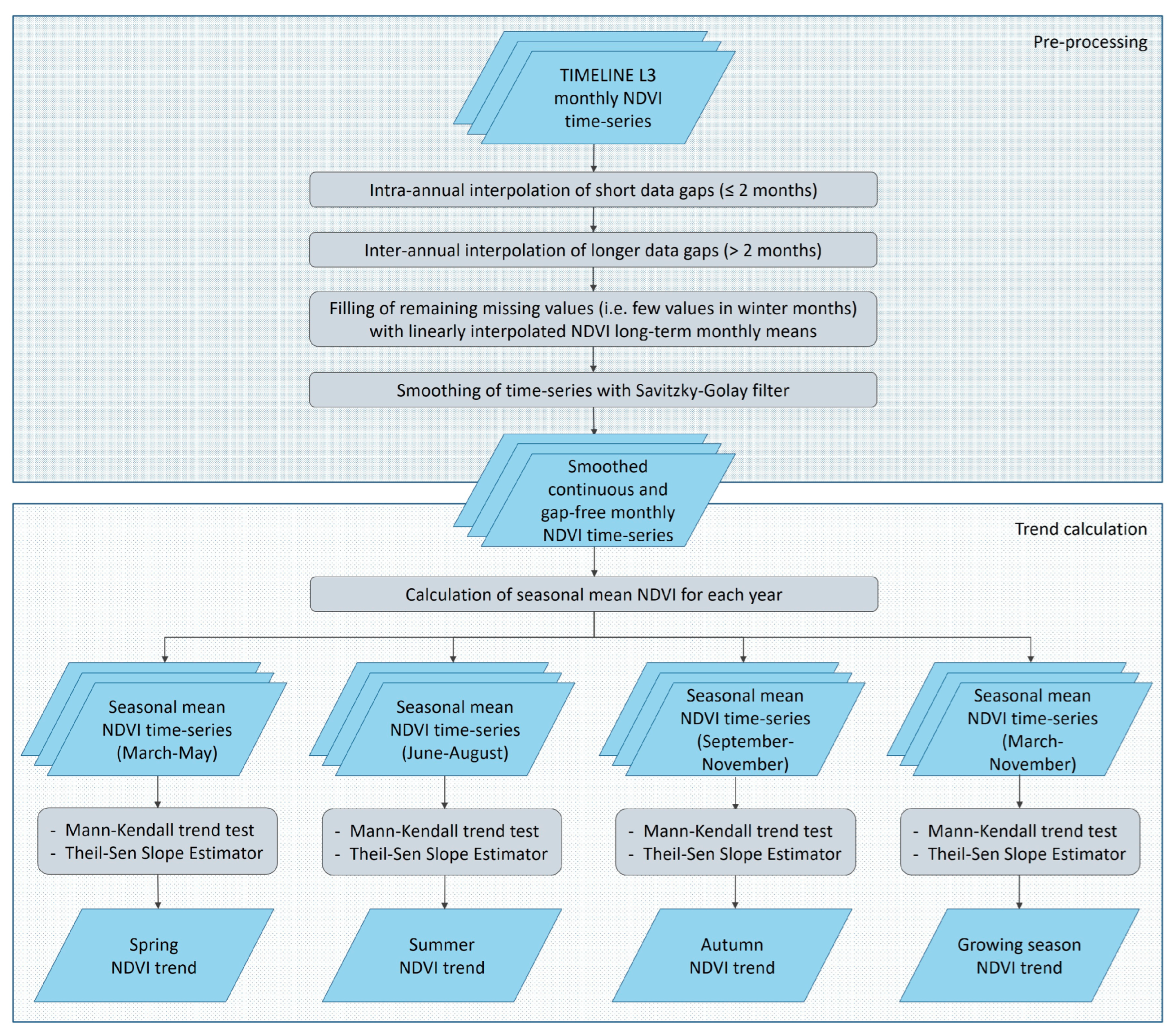
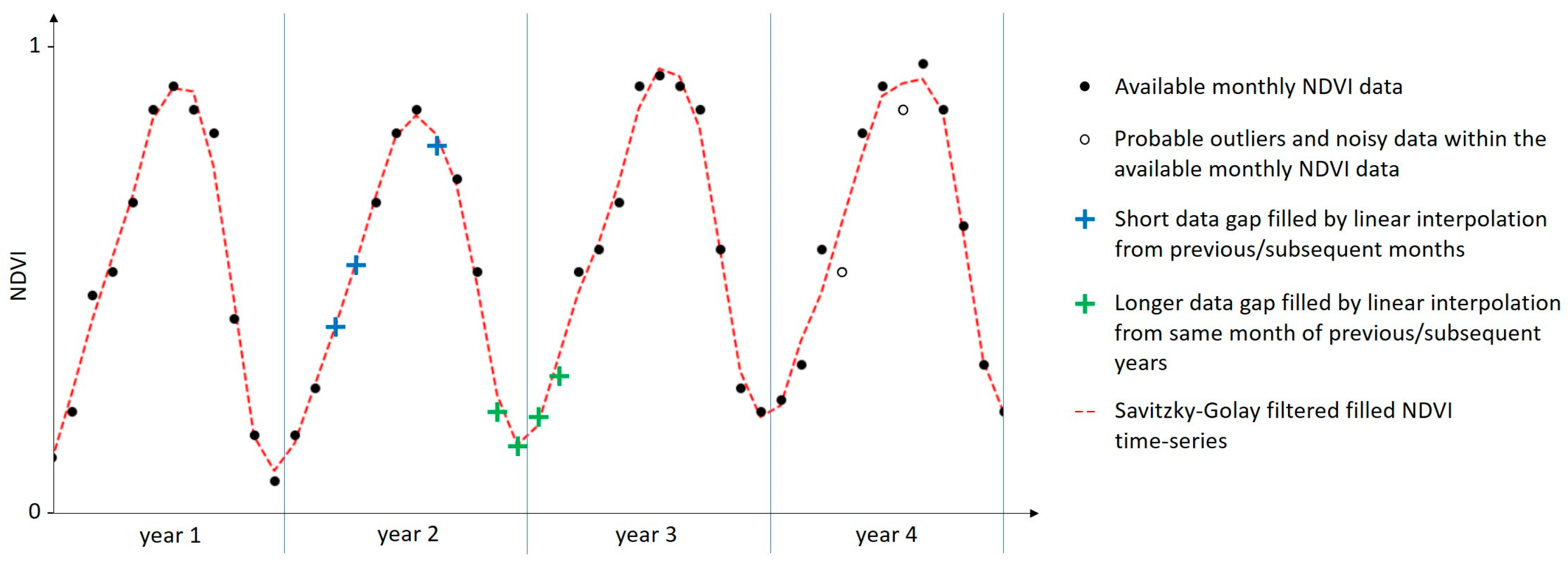
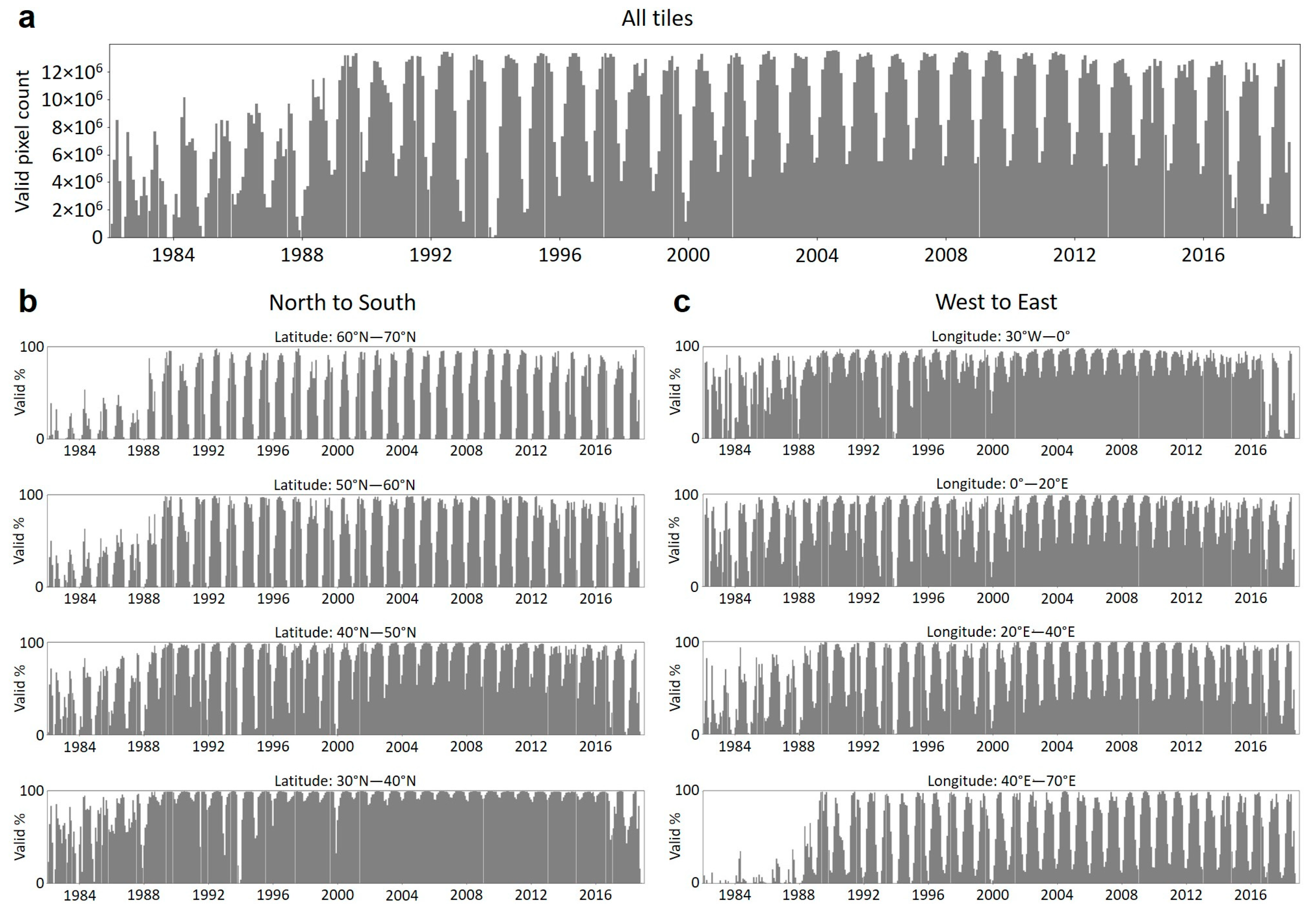
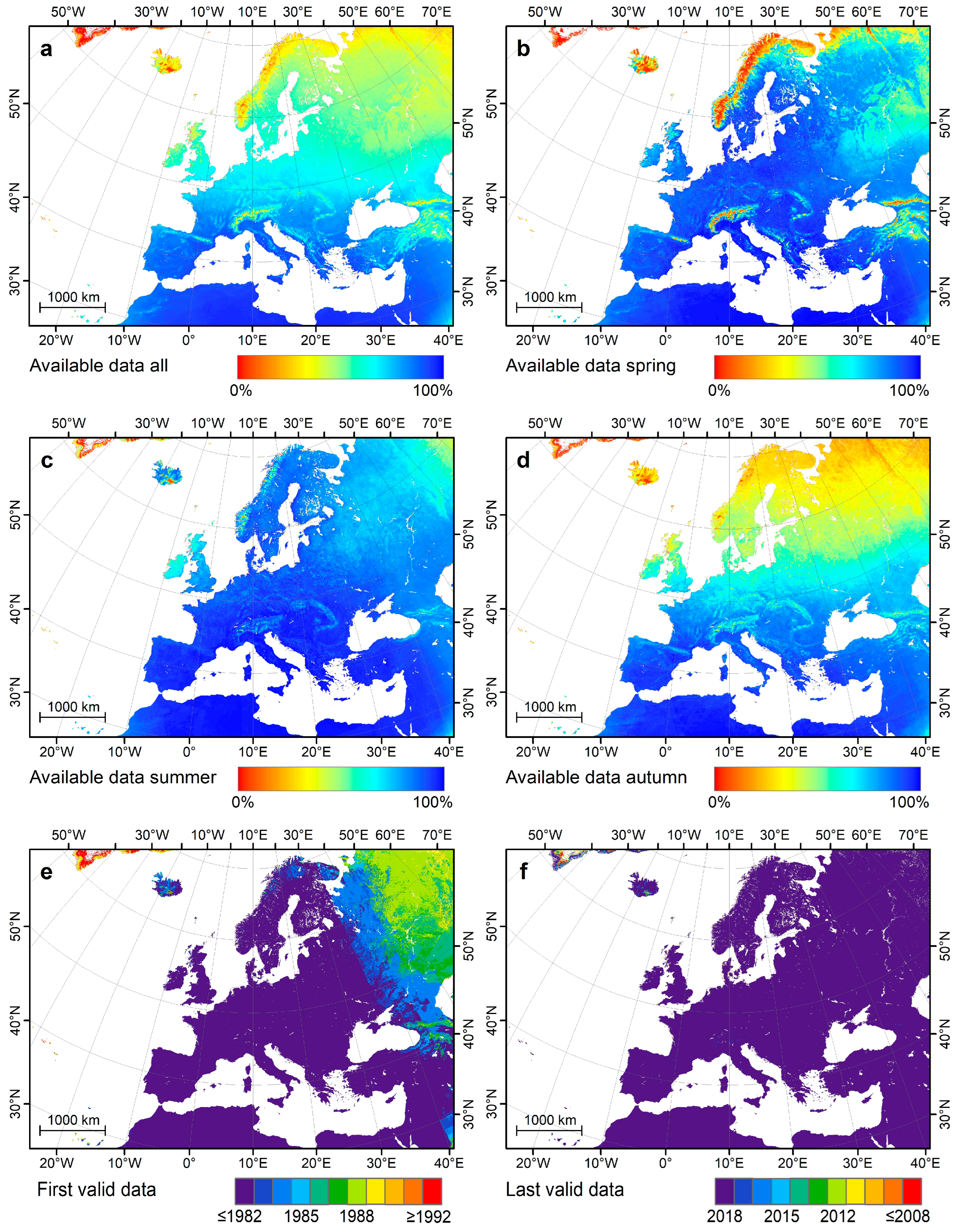
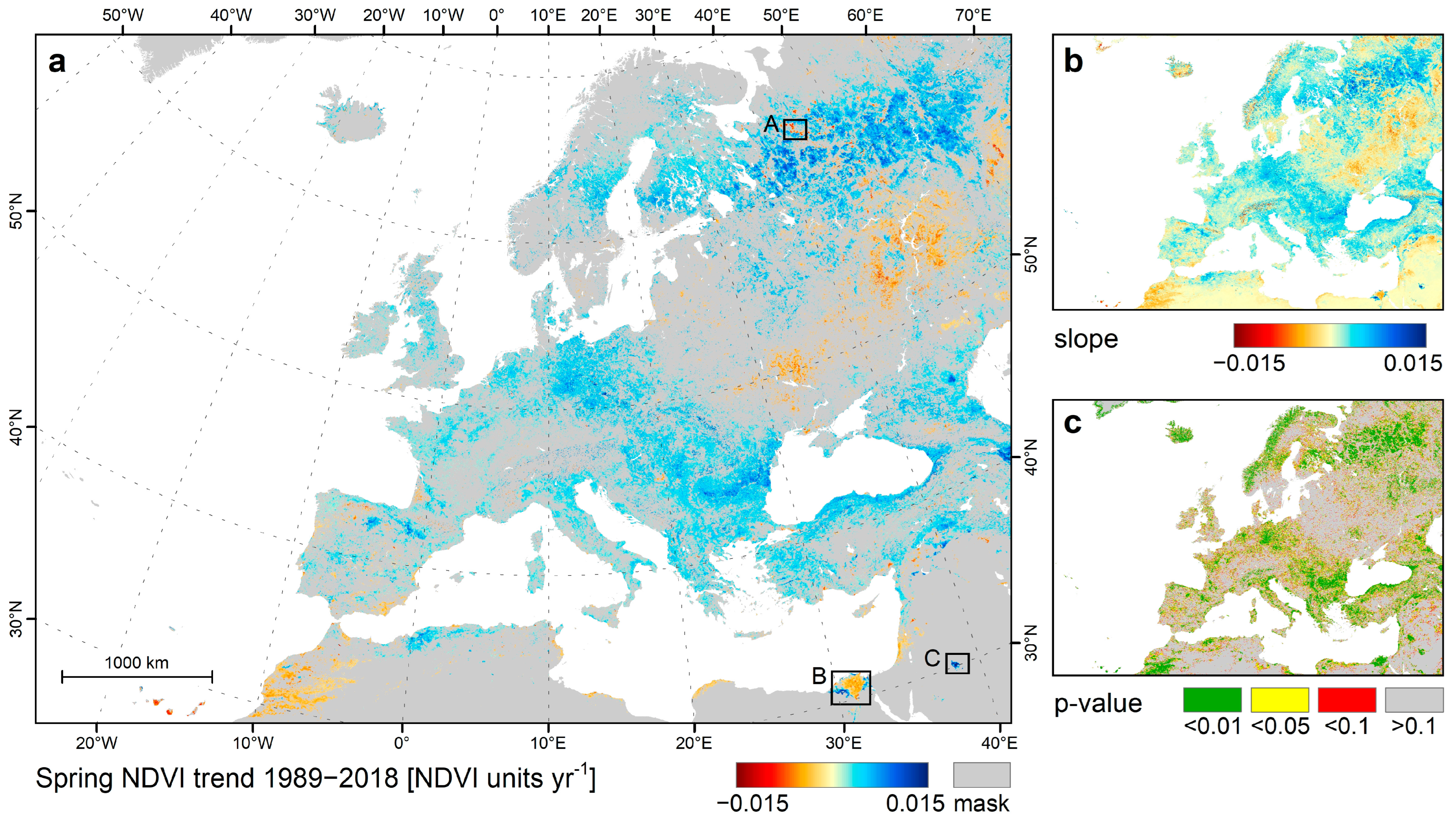
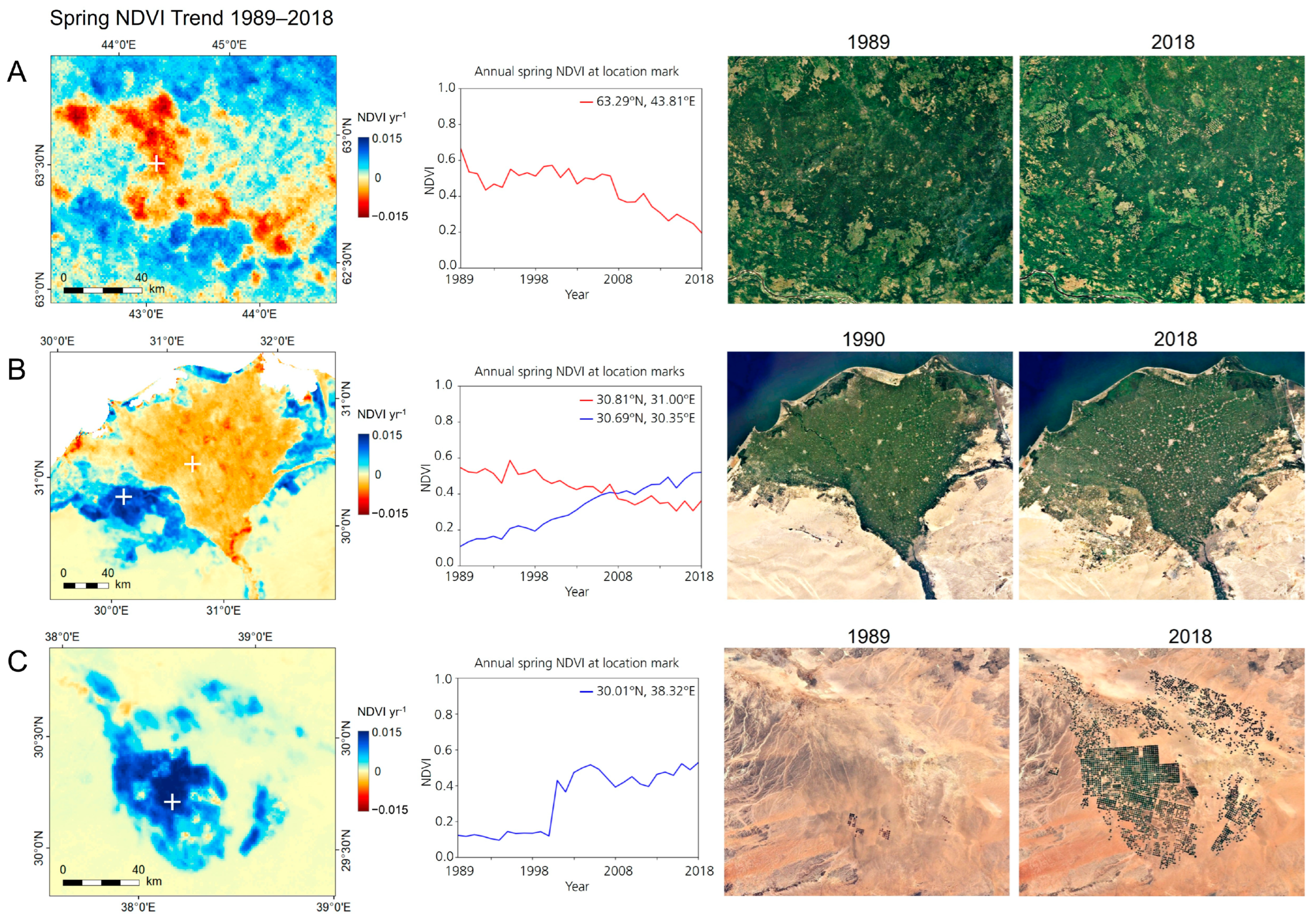
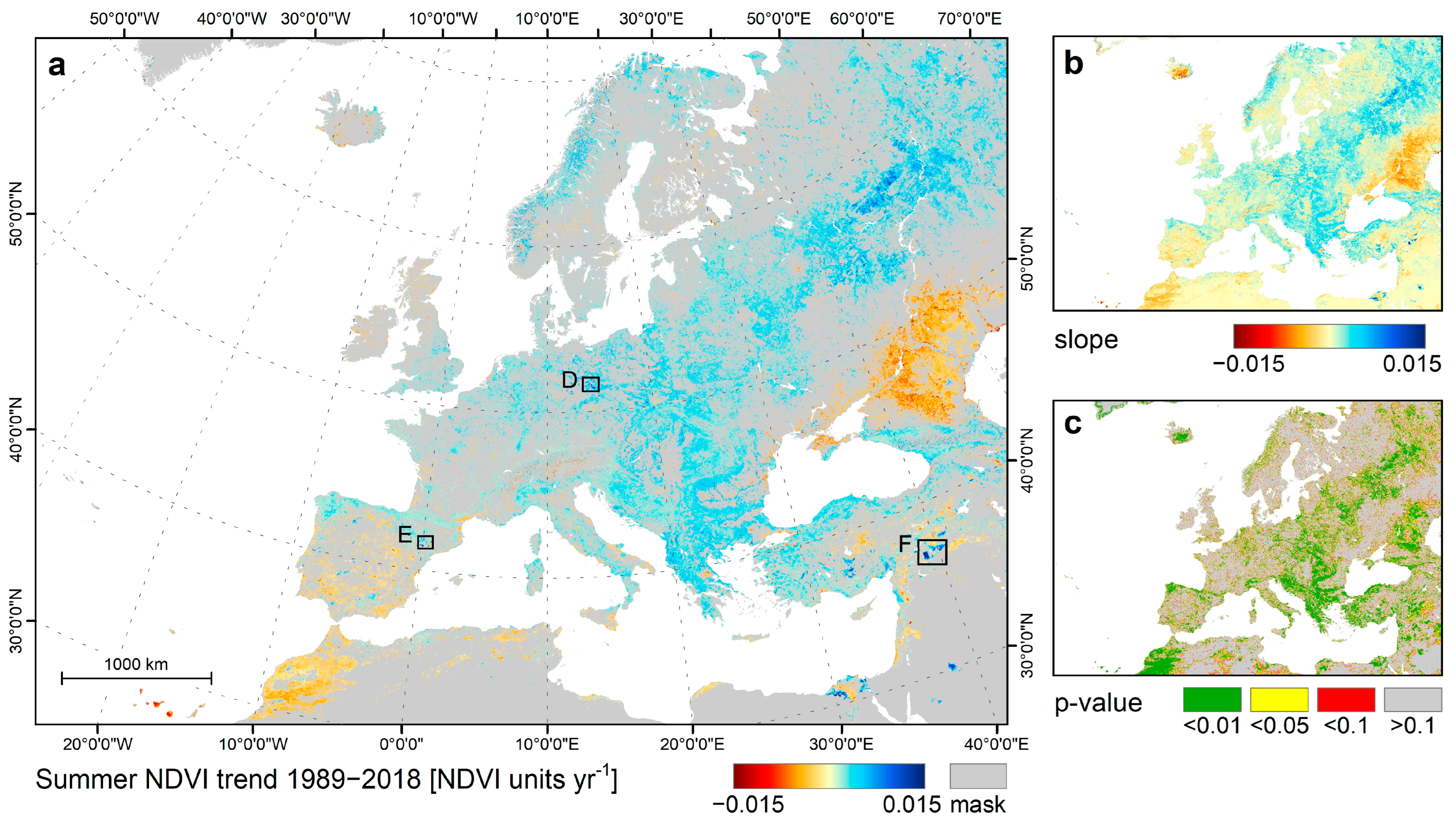
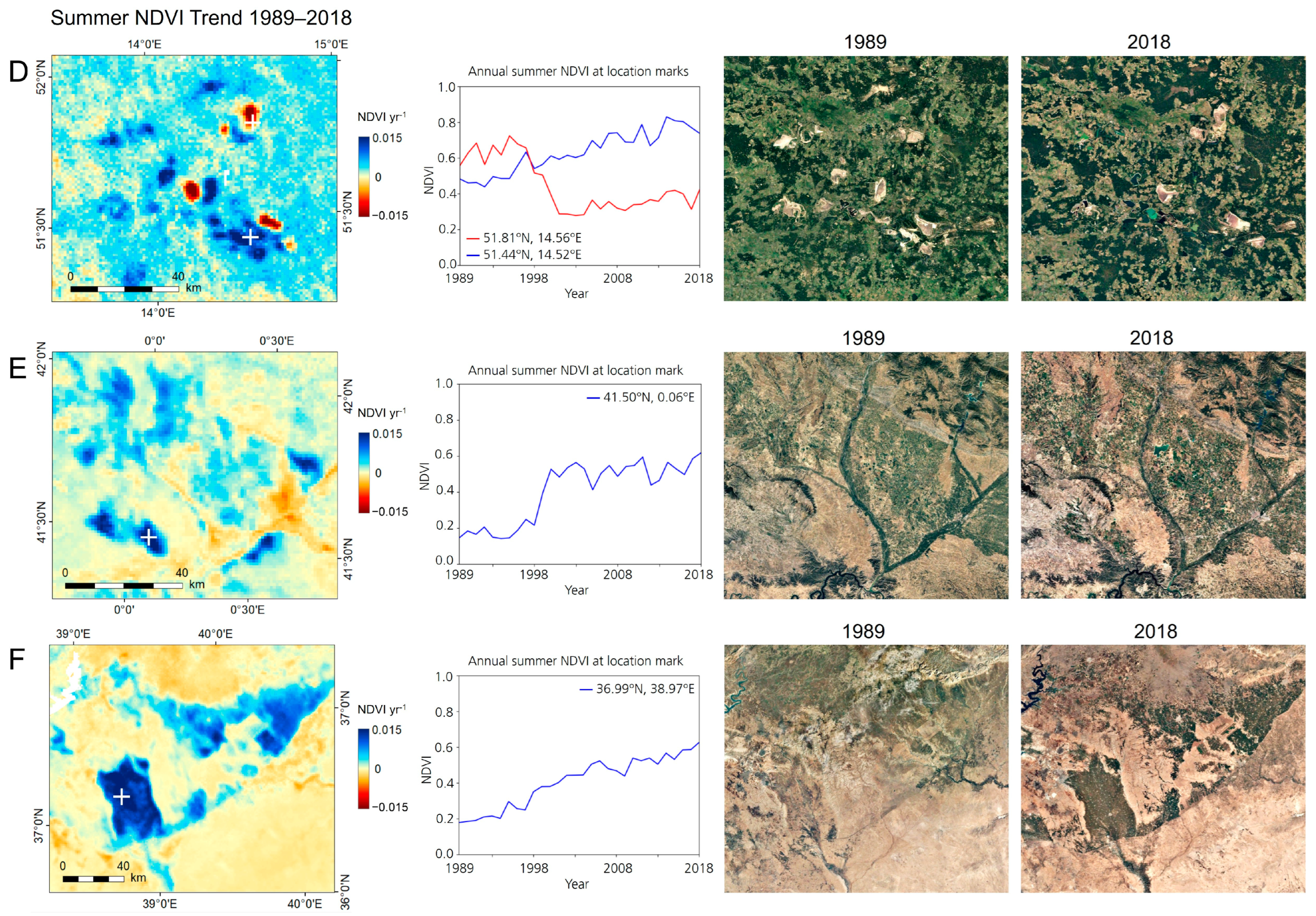
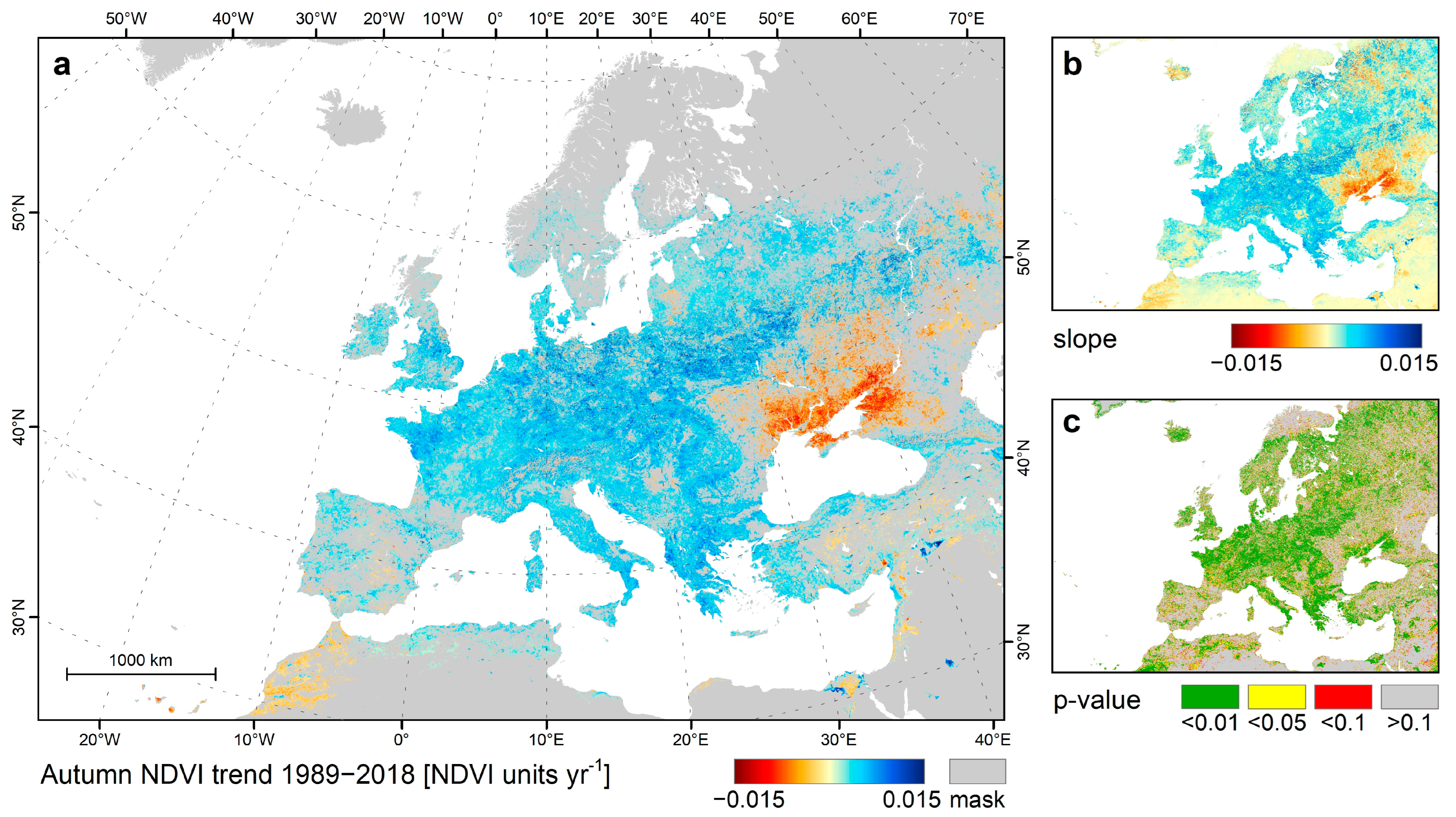
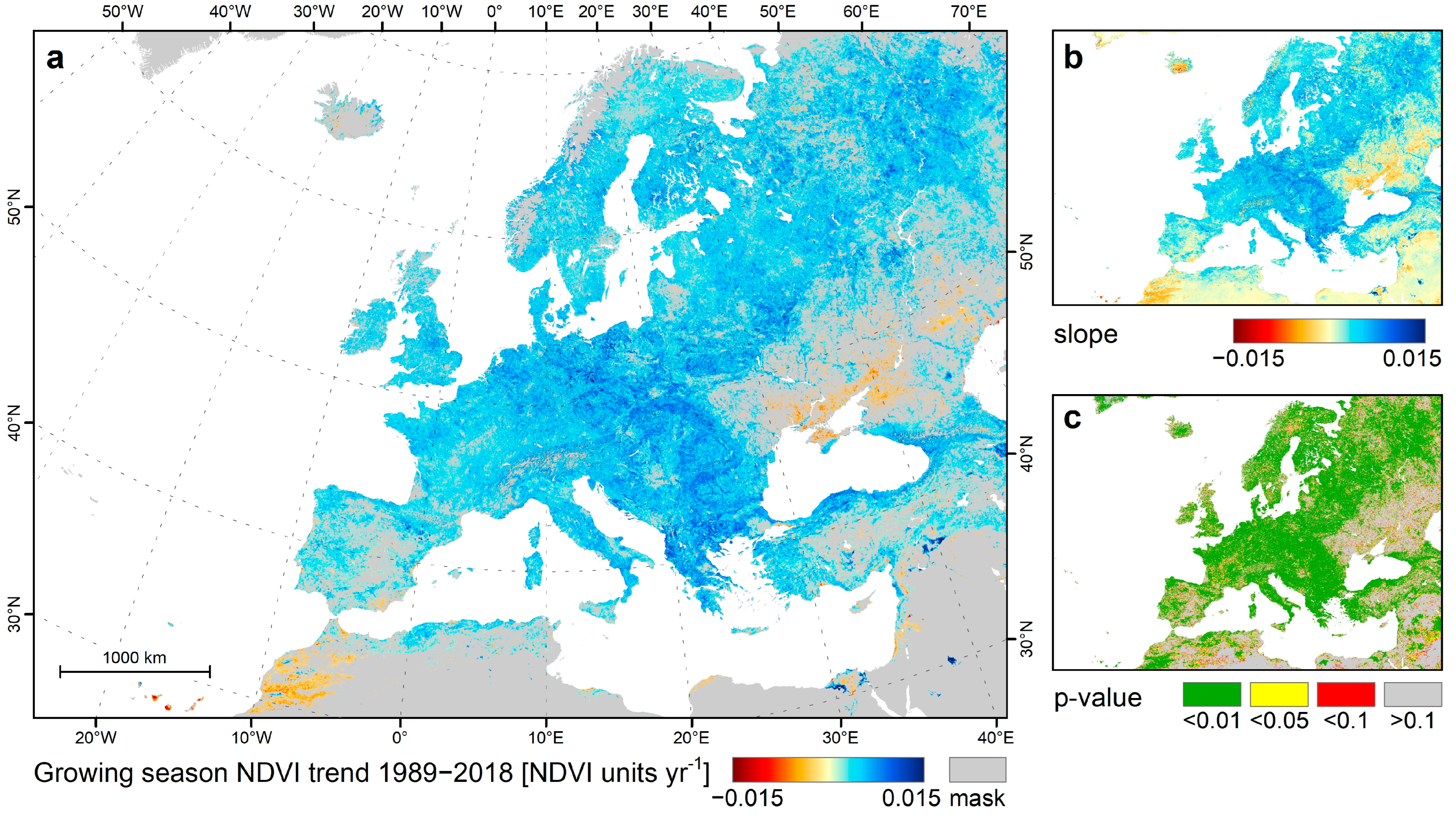
| Daily Composites | Decadal (10-Day) Composites | Monthly Composites | |
|---|---|---|---|
| Time period covered | 9 October 1981–9 November 2018 | Decade-1 October 1981–Decade-1 November 2018 | October 1981–November 2018 |
| Number of composites | 42,067 | 4762 | 1683 |
| Available composites of maximum possible [%] | 77.6 | 89.1 | 94.3 |
| Data volume [GB] | 300.16 | 88.84 | 38.5 |
| Negative (p < 0.05) | Negative (p ≥ 0.05) | Positive (p < 0.05) | Positive (p ≥ 0.05) | Masked Land Area | ||||||
|---|---|---|---|---|---|---|---|---|---|---|
| [%] | [km2] | [%] | [km2] | [%] | [km2] | [%] | [km2] | [%] | [km2] | |
| Spring | 3.61 | 496,748 | 16.58 | 2,281,464 | 20.89 | 2,874,535 | 38.01 | 5,230,305 | 20.91 | 2,877,287 |
| Summer | 6.20 | 853,141 | 20.12 | 2,768,580 | 21.58 | 2,969,481 | 35.87 | 4,935,834 | 16.23 | 2,233,303 |
| Autumn | 4.55 | 626,095 | 10.71 | 1,473,732 | 25.28 | 3,478,614 | 19.03 | 2,618,593 | 40.43 | 5,563,305 |
| Growing season | 2.17 | 298,599 | 7.99 | 1,099,451 | 55.43 | 7,627,356 | 18.44 | 2,537,407 | 15.97 | 2,197,526 |
| Negative (p < 0.05) | Negative (p ≥ 0.05) | Positive (p < 0.05) | Positive (p ≥ 0.05) | |
|---|---|---|---|---|
| Spring | −0.1114 | −0.0320 | 0.1202 | 0.0455 |
| Summer | −0.0992 | −0.0281 | 0.0918 | 0.0319 |
| Autumn | −0.1222 | −0.0346 | 0.1369 | 0.0436 |
| Growing season | −0.1198 | −0.0340 | 0.1483 | 0.0457 |
Disclaimer/Publisher’s Note: The statements, opinions and data contained in all publications are solely those of the individual author(s) and contributor(s) and not of MDPI and/or the editor(s). MDPI and/or the editor(s) disclaim responsibility for any injury to people or property resulting from any ideas, methods, instructions or products referred to in the content. |
© 2023 by the authors. Licensee MDPI, Basel, Switzerland. This article is an open access article distributed under the terms and conditions of the Creative Commons Attribution (CC BY) license (https://creativecommons.org/licenses/by/4.0/).
Share and Cite
Eisfelder, C.; Asam, S.; Hirner, A.; Reiners, P.; Holzwarth, S.; Bachmann, M.; Gessner, U.; Dietz, A.; Huth, J.; Bachofer, F.; et al. Seasonal Vegetation Trends for Europe over 30 Years from a Novel Normalised Difference Vegetation Index (NDVI) Time-Series—The TIMELINE NDVI Product. Remote Sens. 2023, 15, 3616. https://doi.org/10.3390/rs15143616
Eisfelder C, Asam S, Hirner A, Reiners P, Holzwarth S, Bachmann M, Gessner U, Dietz A, Huth J, Bachofer F, et al. Seasonal Vegetation Trends for Europe over 30 Years from a Novel Normalised Difference Vegetation Index (NDVI) Time-Series—The TIMELINE NDVI Product. Remote Sensing. 2023; 15(14):3616. https://doi.org/10.3390/rs15143616
Chicago/Turabian StyleEisfelder, Christina, Sarah Asam, Andreas Hirner, Philipp Reiners, Stefanie Holzwarth, Martin Bachmann, Ursula Gessner, Andreas Dietz, Juliane Huth, Felix Bachofer, and et al. 2023. "Seasonal Vegetation Trends for Europe over 30 Years from a Novel Normalised Difference Vegetation Index (NDVI) Time-Series—The TIMELINE NDVI Product" Remote Sensing 15, no. 14: 3616. https://doi.org/10.3390/rs15143616
APA StyleEisfelder, C., Asam, S., Hirner, A., Reiners, P., Holzwarth, S., Bachmann, M., Gessner, U., Dietz, A., Huth, J., Bachofer, F., & Kuenzer, C. (2023). Seasonal Vegetation Trends for Europe over 30 Years from a Novel Normalised Difference Vegetation Index (NDVI) Time-Series—The TIMELINE NDVI Product. Remote Sensing, 15(14), 3616. https://doi.org/10.3390/rs15143616







